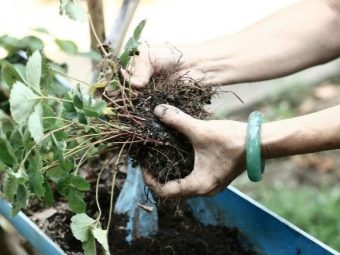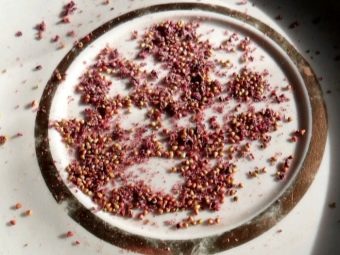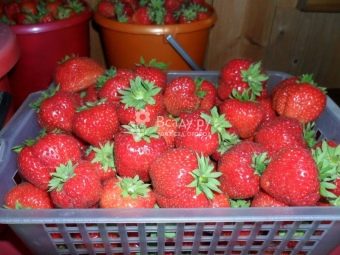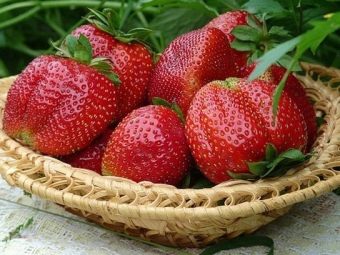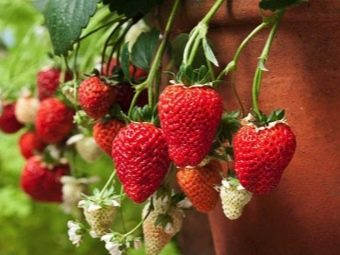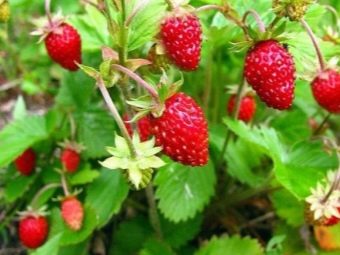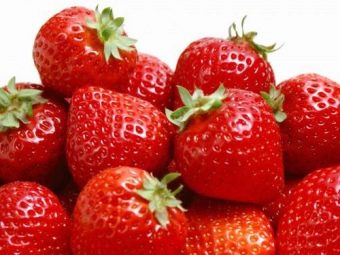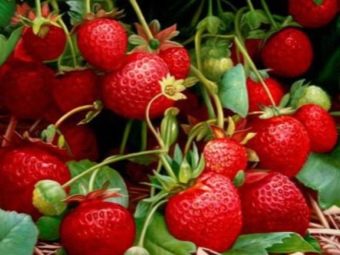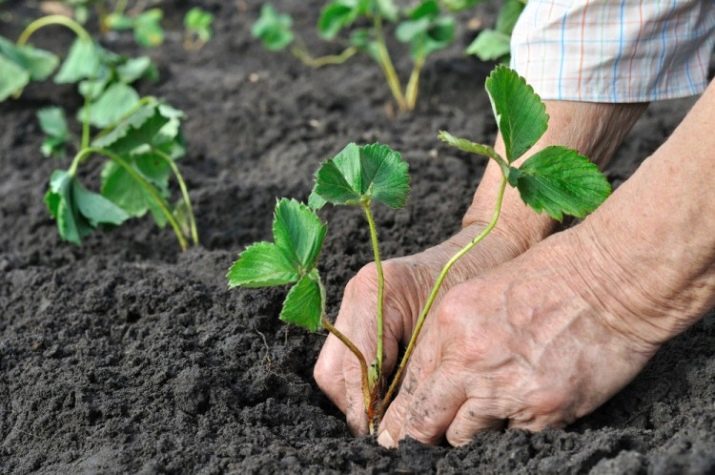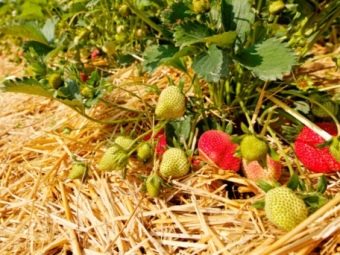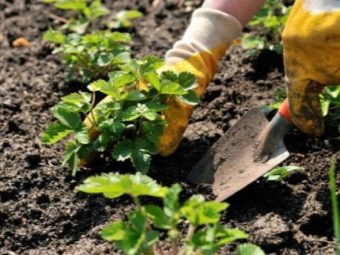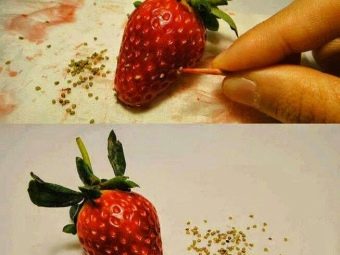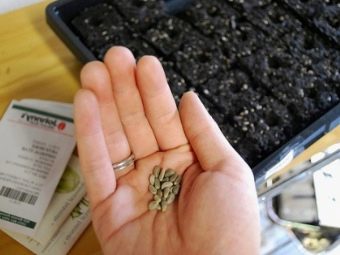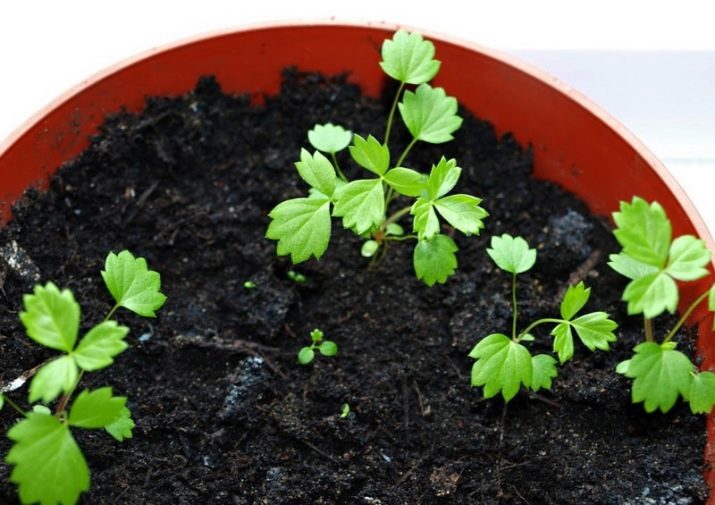Bezusaya Strawberry: Varieties and Cultivation Recommendations
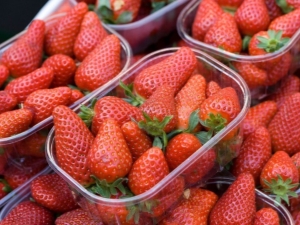
Bezusaya strawberry is much less common in the beds than its “whiskered” relative.However, this atypical variety has many advantages. Apex remontant varieties bear fruit several times, are resistant to low temperatures and do not require special efforts in terms of their care. In addition, as a rule, the berries grow juicy, tasty and rather large.
Features of bezusoy berries
Strawberries without a mustache enjoy the special love of gardeners, as it is remontant and bears fruit several times in one vegetative season. Care for these varieties is much easier, because there is no need to periodically prune the processes to prevent thickening and growth of the culture. In addition, garden strawberries can be planted more closely, which saves space and accommodates more bushes on one bed. A fresh berry can be either large or small.
Propagation of varieties is carried out either with the help of seeds from which the seedlings are grown, or by dividing the bush. The rest of agrotechnics fully coincides with that used for varieties with mustaches. It is worth mentioning that neutral day varieties are often referred to as wild horses. Their peculiarity is that under comfortable conditions, about 5 whiskers form on strawberries, and in hot, dry weather they do not form at all.
Advantages and disadvantages
Reviews of gardeners contain information that one of the main advantages of dry-strawberry is its long-term fruiting - you can pick berries from the third week of June almost until the autumn frosts. Then the benefits of culture include the size and taste of the fruit - they are usually large and very tasty. Also appreciated high yield varieties. Of course, the advantage is a simplified agricultural technology.
But the main drawback of wild strawberries is the inability to tolerate too high temperatures and the absence of moisture. In addition, the complicated reproduction of culture also causes some problems.
Variety selection
The best varieties of bezusey strawberries include Coquette, Queen Elizabeth, Albion, Bolero and others, mostly remontant. Large-fruited “Coquette” ripens quite early and pleases gardeners with orange-red fruits, combining sweetness and sourness in their taste. The weight of one berry is about 23 grams. On one hectare the harvest is going up to 163 centners.
The variety has excellent frost resistance and is not afraid of hot, dry summer months, therefore it is recommended for cultivation in all regions of Russia. For example, it is suitable for the Urals, and for the suburbs.
Bush "Queen Elizabeth" is considered one of the best varieties of remontant berries. The weight of a strawberry sometimes reaches 100 grams, which is a very impressive result. A gardener can get as many as 3 kilograms of a crop from a single bush, and this is perhaps the maximum result for a non-beaten crop. However, the taste of the "Queen" is quite ordinary, although satisfactory. Strawberry frost resistance is good, and the culture is not afraid of even cold winters with a small amount of snow.
Small-fruited garden strawberries “Rügen” are often chosen for Siberia. Harvested from the second half of June until the first frost, and if the bushes are covered, then they bear fruit even longer. The mass of one berry reaches 5 grams, and its flesh is yellow inside and pinkish closer to the surface. As a rule, during the season on one bush gardeners collect almost 1 thousand fruits.
"Bolero" is a large-fruited variety, bred in the USA and pleasing the crop of gardeners from late spring to November. This strawberry is particularly popular, as it successfully develops in all weather conditions and bears fruit regularly.Unlike many other varieties, the berry does not even have to be replanted after 3 years - it can very successfully live on the same bed before the expiration of the five-year period. Bushes "Bolero" is quite compact, and the elongated berries are covered with red-orange peel.
The variety of garden strawberries "Lyubasha" is early and remontant. The mass of one berry reaches 23 grams, which is a very good result. The fruits themselves are very tasty and sugary. The variety is quite resistant to any climatic extremes, is not afraid of low temperatures and dry months and produces up to 104 centners of crop per hectare of land.
"Selva" conditionally refers to wild berries, because under standard weather conditions they are still formed, but in the amount of 5 pieces per season. The mass of one strawberry reaches 75 grams, and its taste is still sour. Culture is bearing fruit from May to October, but in the autumn months shelter is required. A slight inconvenience in growing "Selva" is the need for an annual change of beds and planting new bushes.
Landing
The place for planting without strawberries is chosen in such a way that the beds get enough natural light, but at the same time they do not suffer from drafts.
It would be more correct to begin the landing on the first week of May, when the threat of frost has passed, and the soil and air have warmed enough.
Pre-soil is cleared from weeds and dug up to the depth of a shovel. It is a good idea to feed the selected bed with compost.
Dug holes poured with water, after which the seedlings with an earthy clod neatly placed inside. If there is a desire, then at the same time a growth stimulator is introduced inside. Landings are covered with earth and gently slapped. It will be important to maintain a gap of 40 centimeters between individual plants and maintain inter-row spacing of 70 centimeters.
Care
Caring for bezusoy remontantnoy strawberries stands out by the presence of such a procedure as the removal of peduncles. If you remove the first of them in the spring, then the next will please the berries of a much larger size. In addition, this procedure will allow you to get a harvest early. By the way, when all the strawberries have been gathered, the bushes should ideally be uprooted and burned until the snow begins to fall. It is possible to warm the beds for the winter with the help of straw, hay or sawdust. In the case when the plants remain in the garden, in the spring months the dried leaves are cut with shears in the spring. At the end of this procedure, the space next to it is mulched using lawn grass or special film.
Fruiting culture requires regular irrigation and fertilizing. Mulch will not allow moisture to quickly leave the ground. Each watering is completed by loosening and weeding the beds. As for pests, strawberry most often affects aphids. To prevent the appearance of this insect, you can spray the culture with garlic solution or simply plant the garlic nearby.
Spray strawberries using a spray bottle. In addition, berries are often eaten by wasps. If the aisle is filled with several containers with a sweet liquid in the form of, for example, compote, then it will be possible to divert the attention of insects. The fight against other insects, as well as diseases, is carried out only with the help of commercial solutions.
It is also important to mention that the remontant strawberry bears fruit several times, so usually the first crop is harvested in June, and the second - either in August or in September.
Breeding
Since the breeding of strawberries with a mustache is no longer possible, in this case one will have to use either seeds or dividing the bush. In the first case, the seeds are purchased in the store or carefully removed from the ripened fruit. It is believed that this way you can get the most strong and healthy fruit. A thin knife gently cuts strawberry peel, which is then removed to dry.
Having reached the desired state, it is frayed, as a result of which the seeds are separated. In the next step, the grains are mixed with clean, moistened sand and laid out in glass containers. Capacity is removed for 30 days in the refrigerator.
Planted wild strawberries to be in the second half of February. Soil is pre-prepared from sheet soil and compost. It will be important to pour it with boiling water and a weak solution of potassium permanganate, in addition, it is important to sift the earth. The next stage is planting seeds. Seeds are laid out on top of the ground and covered with a paper napkin, which is periodically moistened. On top of this you will need to put either a polyethylene film or a glass fragment.
In this position, the seeds are kept until the first shoots. It is important to maintain a temperature of 22 degrees Celsius, periodically air plantings and spray them from a spray bottle. When sprouts appear, all artificial devices are removed, and the containers themselves are transferred to where it is sunny. Watering is replaced by a pipette. As soon as the sprouts appear on the second leaf, strawberries can be seated in individual pots or plastic cups. The appearance of the third leaf indicates the need for the introduction of mineral supplements. Before you send the bushes to the garden, they will need some time to adapt to low temperatures, for example, bringing to the balcony.
Speaking of reproduction of bezusoy strawberry by dividing the bush, it is important to start with the fact that this is done either in early spring or early autumn. The beds are pre-dug up, freed from weeds and planting residues, fed with phosphorus and potassium. The holes dug should ideally be 40 centimeters by 40 centimeters.
The whole essence of the division of the bush is that the existing culture, which has reached three years of age, is dug up and divided into several small ones. A new plant is neatly placed in the hole, and its roots are straightened. Immediately, such procedures as irrigation and hilling begin, and after 7 days mulching of the surrounding space takes place.
Review of bezusey strawberries, see the following video.

